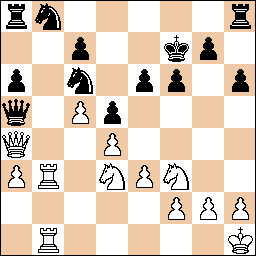Saturday, December 24, 2005
Then What? II

Let's face it, to me this is it, the then what that loses or wins games at crucial moments. I'm not talking about combinations, just simple checks, threats, and captures. The day after my last post I was still working on the above problem because of this unclear sub-variation. I'll tell you in advance that I didn't get it right. Mind you I worked through this problem about 9 months ago 7 times, and even reviewed it twice. Lesson learned: never grow old!
Back to the story. Starting from the the above question, I worked through a variety of Knight moves just to prove they were bad, although something in the back of my mind signaled "mate threat" on the right side of the board. All I could see after 32 Nde5+ fxe5 33 Nxe5+ Kg8 was Ng6, threatening the Rook when the White Queen hangs. I filed it away for later. I couldn't see much difference in the remaining obvious choices 34. Qxa5 or Rxb8. In my mind they were close, both eventually leaving White with a positional advantage and an extra pawn, and Black suffering with a difficult to promote a6 pawn and a backward e6 pawn. I did attempt a long, complete evaluation of both, posted below interspersed with Fritz corrections. I worked through the e6 pawn capture below, also. I went back and thought about adding the Knight to g6 idea, but I couldn't see it do anything good for the position, and therefore didn't change my opinion of either one.
I had a clue, though; 33... Kc8 wasn't chosen by a chess computer. Neither line was as bad as 33... Kf6, so I figured I did something wrong. After some frustration I plugged it into Fritz to find out why. Arrrrg. If you can see which of these choices for 34 is overwhelmingly better, you probably do have the potential to become a master. I just have difficulty realizing there was a line opened along the b1-h7 diagonal, a4-d1 diagonal, and that the King can be forced to move to a vulnerable square. Silly me.
I may be nitpicking, but I think Seirawan did this problem a disservice by leaving this out of his analysis in Winning Chess Tactics, not to mention he had marked this as intermediate as opposed to professional level difficulty. Bad GM!
-=-=-=-=-
Fritz's best in bold, all White +- winning lines, but only one clear best one for White. rn5r/2p2kp1/p1n1pp1p/q1PpN3/Q2P4/PR2PN2/5PPP/1R5K b - - 0 1
1. Nde5+ fxe5 2. Nxe5+ Kg8 3. Rxb8+
(3. Qxa5 Nxa5 4. Rxb8+ Rxb8 5. Rxb8+ Kh7 6.Rxh8+ Kxh8)
3... Rxb8 4. Rxb8+ Kh7?? {This is my idea. I was thinking the Rooks could x-ray protect each other. Strangely 4...Nxb8 Qxa5 +13.00 is marked as best. Urp.} 5. Qc2+ {this line is open !? *smack forehead*} 5...g6 6.Qxg6#
$1 (5. Rxh8+ Kxh8 6. Qxa5 Nxa5 7.Nf7+ Kg8 8. Nd8 e5 9. dxe5 Nc4 10. e6 Kf8 11. Nc6 Nxa3 12. Nb4 Ke7 13. Nxd5+Kxe6 14. Nxc7+ Kd7 15. Nxa6)
(5. Qxa5 Nxa5 6. Nd7
(6. Rxh8+ Kxh8 7. Nf7+ Kg8 8.Nd8 e5 9. dxe5 Nc4 10. e6 Kf8 11. Nc6 Nxa3)
6... Rxb8 7. Nxb8 Kg6 8. Nxa6 c6 9.Nb8 Kf5 10. Nd7 Nc4 11. a4 Ke4 12. Ne5 Nxe5 13. dxe5 d4 14. exd4 Kxd4 15. a5Kxc5 16. f4 g6 17. g4 Kb5 18. f5 gxf5 19. gxf5 exf5 20. e6) *
-=-=-=-=-
34 Rxb8+ Rxb8 (34 ... Nxb8 35 Qe8+ Kh7 36 Qg6+) 35 Rxb8+ Nxb8 36 Qe8+ Kh7 37 Qg6+
Although I cant see through to the end I can see at the least a forced draw by repitition, so I would probably play it OTB knowing that if my opponent errs I could win and if not I can force the draw.
Tough, isn't it? My big problem was not understanding that Kh7 doesn't save Black.
<< Home


